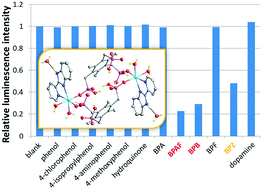A water-stable molecular cadmium phosphonate bearing 2-(2-pyridyl)benzimidazole as a highly sensitive luminescence sensor for the selective detection of bisphenol AF and bisphenol B†
Abstract
A dinuclear molecular cadmium phosphonate, [Cd2(H4tpmm)2(Hpybim)2(H2O)4]·2H2O (1·2H2O), emitting strong luminescence in both solid-state and suspension phases was synthesized by the reaction of Cd(ClO4)2, 2,4,6-tris(phosphorylmethyl)mesitylene (H6tpmm), and 2-(2-pyridyl)benzimidazole (Hpybim) via the slow diffusion of reactants. Complex 1·2H2O showed very poor solubility but high chemical stability in common organic solvents and H2O. Furthermore, 1·2H2O also revealed good thermal stability upon heating to 325 °C. Luminescence detection on a series of phenolic analytes within 5 min response time showed that bisphenol AF (BPAF) and bisphenol B (BPB) significantly reduced the luminescence intensity of 1·2H2O in water, with the quenching efficiencies of 77 and 71%, respectively, while bisphenol Z (BPZ) moderately quenched the luminescence of 1·2H2O in water by 52%. The Stern–Volmer quenching constant, Ksv, and the limit of detection (LOD) were determined to be 1931 M−1 and 12.8 μM for BPAF, 515 M−1 and 14.6 μM for BPB, and 2269 M−1 and 3.0 μM for BPZ. In addition, 1·2H2O behaving as a luminescence sensor has an exclusive detection for BPAF, BPB, and BPZ over a wide range of interfering phenolic analytes, with the exception of dopamine toward BPB. This work demonstrates a highly water-stable molecular cadmium phosphonate suitable for the luminescence detection of bisphenols, endocrine-disrupting chemicals, especially BPAF and BPB, in water.

- This article is part of the themed collection: Crystal Growth


 Please wait while we load your content...
Please wait while we load your content...